The 2016 Chevrolet Cruze is a comfy cruiser with useful everyday tech
Can Chevy win over millennials and empty-nesters?

Small American cars faced tough competition since the first Japanese cars reached Western shores. There was the Chevy Vega, Monza, Chevette, Cavalier, Cobalt and HHR.
I vaguely remember the Chevy Vega, one of the first cars my family purchased when we immigrated to the states. Hell, the first car I purchased as a college graduation present to myself was a turbocharged, 2008 Chevrolet HHR SS with the Saab-sourced 5-speed manual transmission.
Despite the fun-to-drive nature and the love-it-or-hate it looks of the HHR, the interior consisted of hard plastic surfaces devoid of technology – it wasn't an appealing place to be.
But, things started turning around with the Chevy Cruze, as General Motors (GM) focused on creating balanced cars with higher-quality interiors, refined road manners and enjoyable driving dynamics on all cars – not just the hopped up SS models.
Now, on its second-generation, the Cruze isn't the frumpy Cobalt or retro-inspired HHR you remember from the late aughts. The latest, 2016 Cruze sports Chevy's latest styling language, which debuted with the 2014 Impala and trades boring beige for dynamic styling that evokes a sporty look.
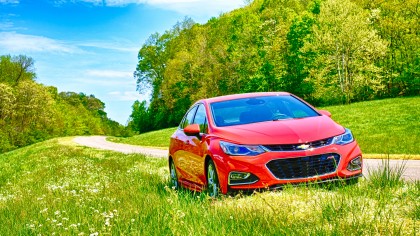
The styling flows well with its pronounced wheel arches and swooping lines that integrate the door handles. Chevy incorporates projector-beam halogen headlights with black housings to give the LT and higher trims an aggressive demeanor.
To sample the latest iteration of the Cruze, I packed my bags, loaded up my Apple Music playlist with some Brad Paisley and hopped a plane to Nashville, Tenn., the home of country music and southern hospitality. I hopped behind the wheel of a fully-loaded Cruze Premier with all the technology options checked off to, you know, #findnewroads.
Get daily insight, inspiration and deals in your inbox
Sign up for breaking news, reviews, opinion, top tech deals, and more.
After a couple gallons of sweat tea and more deep fried foods than my arteries could handle, I walked away impressed by the new Cruze, despite having to #findnewpants.
The technology
Chevy is targeting millennials and empty-nesters with the Cruze. Smartphone connectivity and driver assists are what Chevy wants to entice buyers with.
At the heart of the infotainment system is a Chevrolet MyLink dashboard unit. Base models receive a 7-inch display, while the top-end Premier I drove sported an 8-inch display.
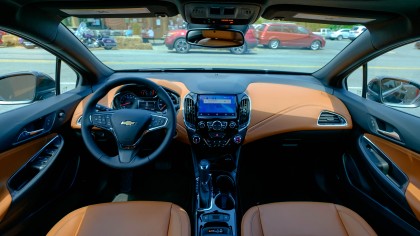
Integrated navigation capabilities are included with the Premier trim level, but they're not really necessary. All Chevy Cruze trim levels support Android Auto and Apple CarPlay to let your smartphone take control, which is all you really need in a car.
The native user interface is a basic 2 x 4 icon grid layout on a black background, but it lacks the slick, buttery-smooth transitions of Ford's SYNC 3. I used it briefly but found myself switching to Android Auto, as I prefer my Google Now information. Apple CarPlay was tested and works smoothly, too.
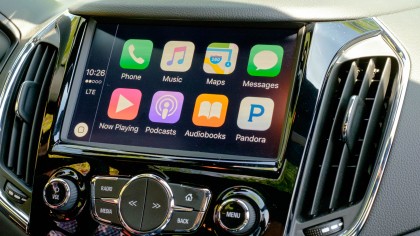
When using Android Auto or Apple CarPlay, a single press of the steering wheel-mounted voice command button still triggers voice commands for the Chevy MyLink functions. You have to hold the voice command button down for a few seconds to trigger Siri or Google Now, which is a minor annoyance that Ford solves with SYNC 3.
An integrated combination wireless charger that supports PMA and Qi standards is installed in the center console between the arm rest and cup holders. I tried to insert my Motorola Nexus 6, but it was a smidge too wide to fit into the slot.
I can't fault Chevy for that, because the Nexus 6 is an abnormally large phone that pushes the size limit of every in-car wireless charger I've come across.
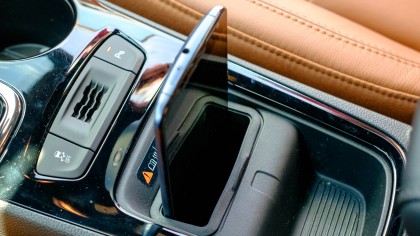
On-board 4G LTE data capabilities via OnStar enable the Cruze to provide Wi-Fi hotspot capabilities for passengers. Chevy includes 2 years or 24GB of data for the on-board internet connection in the Cruze LT and higher trim levels.
I must commend Chevy for the gesture, because it's a compelling reason to use the in-car hot-spot instead of tethering off my phone.
The subscription includes five years of OnStar Guidance, that lets you remote start, lock, unlock the car and view vehicle information from a smartphone app, too. OnStar Guidance also provides automatic emergency services and stolen vehicle assistance, too.
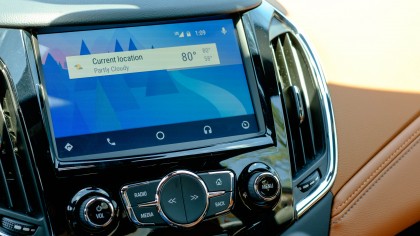
A 24 month subscription to SiriusXM is included on LT and higher trim levels as well.
Check off the Driver Confidence II package, and you get Chevy's suite of driver assists, which include forward collision alert (FCW), lane keep assist (LKAS) and blind spot monitor (BSM).
Adaptive cruise control isn't available on the Cruze, unlike the Hyundai Elantra, Honda Civic and Mazda 3. However, Chevy's FCW system is superior to the aforementioned trio.
Instead of flashing a "BRAKE" image in the gauge cluster LCD and beeping profusely, a cluster of LEDs is installed at the top of the dashboard.
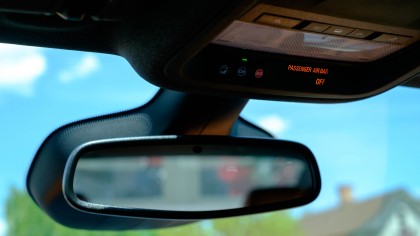
The LED cluster projects a bright orange light to grab your attention if the system detects a potential collision. I find the bright flashing lights at eye-level much more effective at grabbing my attention than having to glance down at the gauge cluster.
Chevy's LKAS system actively monitors the lane markers to help keep you from veering out of the lane. You turn the system on with a press of the button on the steering wheel. It automatically turns on after hitting the ignition, unlike Honda's system that requires manual engagement every time you push-to-start.
The LKAS keeps the car within the lane, even if I briefly let go of the steering wheel. There's an indicator in the gauge cluster that lights up green when to signify the system can read the lanes.
The drive
The previous-generation Cruze gave American buyers a taste of smaller, turbocharged motivation with an optional 1.4-liter, in addition to the base naturally aspirated 1.8-liter, motor. Chevy ditches the 1.8-liter for a single 1.4-liter force-fed motor on all Cruze trim levels, mated with a choice of 6-speed automatic or manual transmissions.
It's a new and improved 1.4-liter that bumps this whip's oomph to 153 horsepower (hp) and 177 pound-feet (lb.-ft.) of torque, a mild 10% hp and 20% torque boost. You cannot get the fully-loaded Cruze Premier with a third pedal, unfortunately.
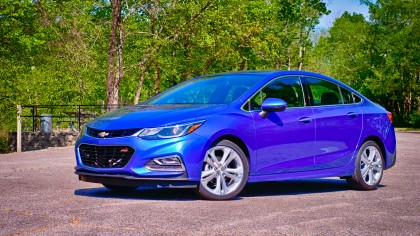
Start/stop technology is thrown into the mix for a US Environmental Protection Agency fuel economy rating of 30 miles per gallon (mpg) in the city, 42 mpg on the highway and 35 mpg combined.
I was only able to drive the six-speed automatic, and the powertrain is fantastic. Power delivery around town with 177 lb.-ft. of instantaneous torque makes the vehicle truly scoot and enjoyable to drive. The little engine doesn't fizzle out at highway speeds either and offers plenty of passing power.
It's no speed demon by any means, but it's quite peppy. Chevy's start/stop technology is excellent in the Cruze, it wasn't too noticeable and could put some luxury vehicles to shame with how well-controlled the NVH (noise, vibration and harshness) is.
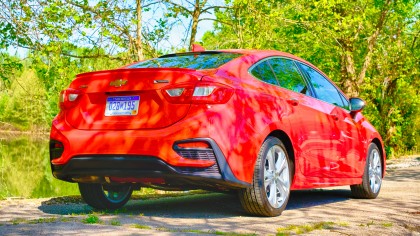
The ride is comfortable with supple dampening and a quiet cabin. Steering response is precise, but steering feels extremely light. Light steering makes the Cruze awfully easy to drive along the windy Tennessee roads, but I personally prefer a more weighted steering experience.
Chevy doesn't offer different steering feel modes either, so you're stuck with a light steering feel. But, if you prefer light steering to effortlessly drive around town and navigate parking lots, the Cruze is up for the task.
Final verdict
Chevy has come a long way in the last decade. The second-generation Cruze is a major leap in refinement for Chevy's compact offering. This isn't the Cobalt or Cavalier you may remember, but a comfortable cruiser with useful, everyday technology and high-quality interior materials.
The MyLink infotainment system is responsive, but the crown jewel is Android Auto and Apple CarPlay support on all trim levels. So, you're getting an excellent infotainment experience regardless of whether you spend $17,000 or $28,000.
The two years of 24GB of data connectivity for the integrated Wi-Fi hot-spot is nice to have. But, if you have a shared data plan with tethering, it's not a compelling reason to choose the Cruze over other compacts.
The available LKAS is superb and keeps the car within the lane markers. However, not offering ACC leaves the Cruze behind the more commute-friendly Civic with Honda Sensing technology that can stop the car completely and hold it in stop-and-go traffic.
However, Chevy's dash-mounted cluster of warning LEDs for its FCW system is the best method of warning I've seen in a compact car. It definitely catches your attention without having to glance down at the gauge cluster to read the "brake" message that Honda and Hyundai use.
Ultimately, the second-generation Chevy Cruze is a balanced compact with striking styling, excellent infotainment system and refined driving dynamics. I wouldn't hesitate to recommend it to anyone that wants a stylish, fuel-efficient and comfortable everyday car.